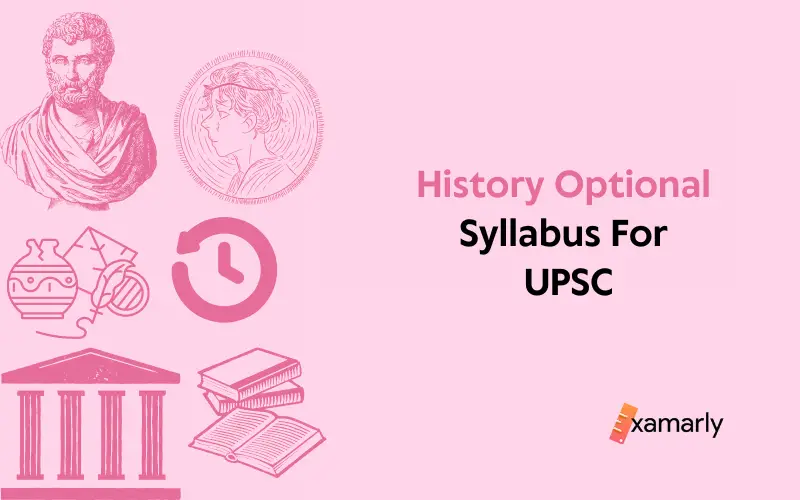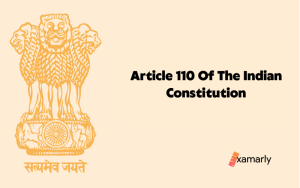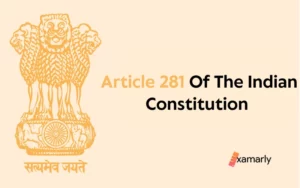To achieve the fruits of success, meticulous and strategic planning is extremely crucial. In highly competitive exams such as the UPSC, thoughtful planning and execution of the study plan can reap wonderful results. That is why being familiar with the syllabus of the chosen subject should be the initial task of the candidate before jumping into the subject.
There is a multitude of subjects offered as part of the UPSC optional subject list. History is one of those subjects which candidates can opt for. The History optional syllabus sets out to test the candidate’s awareness of chronological events of the past along with their ability to understand the techniques employed to learn the subject. History is a part of the General Studies Paper I of the IAS mains exam.
Acquaint yourself with the important aspects related to the History optional syllabus for UPSC
History Syllabus For UPSC
History is one of the most preferred optional subjects for the UPSC Mains exam. It covers a variety of topics such as archaeology, archaeological sources, historical architecture, culture and heritage. Candidates may find the syllabus of UPSC mains manageable after getting versed with the History optional syllabus for UPSC.
Candidates have to appear for two papers for the History optional subject exam in UPSC Mains. The history optional subject comprises 2 papers, namely- Paper I and Paper II. For ease of understanding, the subject has been divided into 4 parts. This simplification provides scope for a better preparation strategy as well. The weightage of each of these papers is 250 marks. So, the total of each paper equates to 500 marks.
Paper – I: Ancient India
Paper – I: Medieval India
Paper – II: Modern India
Paper – II: World History
History Optional Syllabus For UPSC For Paper I:
1. Sources
Archaeological sources :
Exploration, excavation, epigraphy, numismatics, monuments.
Literary sources:
Indigenous: Primary and secondary; poetry, scientific literature, literature, literature in regional languages, religious literature.
Foreign account: Greek, Chinese and Arab writers.
2. Pre‐history and Proto‐history :
Geographical factors; hunting and gathering (paleolithic and mesolithic); Beginning of agriculture (neolithic and chalcolithic).
3. Indus Valley Civilization :
Origin, date, extent, characteristics-decline, survival and significance, art and architecture.
4. Megalithic Cultures :
Distribution of pastoral and farming cultures outside the Indus, Development of community life, Settlements, Development of agriculture, Crafts, Pottery, and Iron industry.
5. Aryans and Vedic Period :
Expansions of Aryans in India :
Vedic Period: Religious and philosophic literature; Transformation from Rig Vedic period to the later Vedic period; Political, social, and economical life; Significance of the Vedic Age; Evolution of Monarchy and Varna system.
6. Period of Mahajanapadas :
Formation of States (Mahajanapada): Republics and monarchies; Rise of urban centers; Trade routes; Economic growth; Introduction of coinage; Spread of Jainism and Buddism; Rise of
Magadha and Nandas.
Iranian and Macedonian invasions and their impact.
7. Mauryan Empire :
Foundation of the Mauryan Empire, Chandragupta, Kautilya, and Arthashastra; Ashoka; Concept of Dharma; Edicts; Polity, Administration, Economy; Art, architecture, and sculpture; External contacts; Religion; Spread of religion; Literature.
The disintegration of the empire; Sungas and Kanvas.
8. Post‐Mauryan Period (Indo‐Greeks, Sakas, Kushanas, Western Kshatrapas) :
Contact with the outside world; growth of urban centers, economy, coinage, development of religions, Mahayana, social conditions, art, architecture, culture, literature, and science.
9. Early State and Society in Eastern India, Deccan, and South India:
Kharavela, The Satavahanas, the Tamil States of the Sangam Age; Administration, Economy, land grants, coinage, trade guilds, and urban centers; Buddhist centers; Sangam literature and culture; Art and architecture.
10. Guptas, Vakatakas and Vardhanas:
Polity and administration, Economic conditions, Coinage of the Guptas, Land grants, Decline of urban centers, Indian feudalism, Caste system, Position of women, Education and educational institutions; Nalanda, Vikramshila and Vallabhi, Literature, scientific literature, art, and architecture.
11. Regional States during Gupta Era:
The Kadambas, Pallavas, and Chalukyas of Badami; Polity and Administration, Trade guilds, Literature; growth of Vaishnava and Saiva religions. Tamil Bhakti movement, Shankaracharya;
Vedanta; Institutions of temple and temple architecture; Palas, Senas, Rashtrakutas, Paramaras, Polity, and administration; Cultural aspects. Arab conquest of Sind; Alberuni, The Chalukyas of Kalyana, Cholas, Hoysalas, Pandyas; Polity and Administration; Local Government; Growth of art and architecture, religious sects, Institution of temple and Mathas, Agraharas, education and literature, economy and society.
12. Themes in Early Indian Cultural History:
Languages and texts, major stages in the evolution of art and architecture, major philosophical thinkers and schools, and ideas in Science and Mathematics.
13. Early Medieval India, 750‐1200:
- Polity: Major political developments in Northern India and the peninsula, origin, and the rise of Rajputs.
- The Cholas: administration, village economy, and society “Indian Feudalism”.
- Agrarian economy and urban settlements.
- Trade and commerce.
- Society: the status of the Brahman and the new social order.
- Condition of women.
- Indian science and technology.
14. Cultural Traditions in India, 750‐1200:
- Philosophy: Skankaracharya and Vedanta, Ramanuja and Vishishtadvaita, Madhva and Brahma-Mimansa.
- Religion: Forms and features of religion, Tamil devotional cult, growth of Bhakti, Islam and its arrival in India, Sufism.
- Literature: Literature in Sanskrit, growth of Tamil literature, literature in the newly developing languages, Kalhan’s Rajtarangini, Alberuni’s India.
- Art and Architecture: Temple architecture, sculpture, painting.
15. The Thirteenth Century:
- Establishment of the Delhi Sultanate: The Ghurian invasions – factors behind Ghurian success.
- Economic, Social, and cultural consequences.
- Foundation of Delhi Sultanate and early Turkish Sultans.
- Consolidation: The rule of Iltutmish and Balban.
16. The Fourteenth Century:
- “The Khalji Revolution”.
- Alauddin Khalji: Conquests and territorial expansion, agrarian and economic measure.
- Muhammad Tughluq: Major projects, agrarian measures, the bureaucracy of Muhammad Tughluq.
- Firuz Tugluq: Agrarian measures, achievements in civil engineering and public works, the decline of the Sultanate, foreign contacts, and Ibn Battuta’s account.
17. Society, Culture, and Economy in the Thirteenth and Fourteenth Centuries:
- Society: composition of rural society, ruling classes, town dwellers, women, religious classes, caste, and slavery under the Sultanate, Bhakti movement, and Sufi movement.
- Culture: Persian literature, literature in the regional languages of North India, literature in the languages of South India, Sultanate architecture and new structural forms, painting, and evolution of a composite culture.
- Economy: Agricultural Production, the rise of urban economy and non-agricultural production, trade, and commerce.
18. The Fifteenth and Early Sixteenth Century‐Political Developments and Economy:
- Rise of Provincial Dynasties: Bengal, Kashmir (Zainul Abedin), Gujarat.
- Malwa, Bahmanids.
- The Vijayanagara Empire.
- Lodis.
- Mughal Empire, first phase: Babur, Humayun.
- The Sur Empire: Sher Shah’s administration.
- Portuguese colonial enterprise, Bhakti, and Sufi Movements.
19. The Fifteenth and Early Sixteenth Century‐ Society and culture:
- Regional culture specificities.
- Literary traditions.
- Provincial architectural.
- Society, culture, literature, and the arts in Vijayanagara Empire.
20. Akbar:
- Conquests and consolidation of empire.
- Establishment of jagir and mansab systems.
- Rajput policy.
- Evolution of religious and social outlook. Theory of Sulh‐i‐kul and religious policy.
- Court patronage of art and technology.
21. Mughal Empire in the Seventeenth Century:
- Major administrative policies of Jahangir, Shahjahan, and Aurangzeb.
- The Empire and the Zamindars.
- Religious policies of Jahangir, Shahjahan, and Aurangzeb.
- Nature of the Mughal State.
- Late Seventeenth Century crisis and the revolts.
- The Ahom kingdom.
- Shivaji and the early Maratha Kingdom.
22. Economy and society, in the 16th and 17th Centuries:
- Population Agricultural and craft production.
- Towns, commerce with Europe through Dutch, English, and French companies: a trade revolution.
- Indian mercantile classes. Banking, insurance, and credit systems.
- Conditions of peasants, Condition of Women.
- Evolution of the Sikh community and the Khalsa Panth.
23. Culture during Mughal Empire:
- Persian histories and other literature.
- Hindi and religious literature.
- Mughal architecture.
- Mughal painting.
- Provincial architecture and painting.
- Classical music.
- Science and technology.
24. The Eighteenth Century:
- Factors for the decline of the Mughal Empire.
- The regional principalities: Nizam’s Deccan, Bengal, Awadh.
- Maratha ascendancy under the Peshwas.
- The Maratha fiscal and financial system.
- Emergence of Afghan power Battle of Panipat, 1761.
- State of, political, cultural, and economic, on eve of the British conquest.
UPSC Syllabus History Optional Paper II:
- European Penetration into India: The Early European Settlements; The Portuguese and the Dutch; The English and the French East India Companies; Their struggle for supremacy; Carnatic Wars; Bengal-The conflict between the English and the Nawabs of Bengal; Siraj and the English; The Battle of Plassey; Significance of Plassey.
- British Expansion in India: Bengal-Mir Jafar and Mir Kasim; The Battle of Buxar; Mysore; The Marathas; The three AngloMaratha Wars; The Punjab.
- Early Structure of the British Raj: The Early administrative structure; From diarchy to direct control; The Regulating Act (1773); The Pitt’s India Act (1784); The Charter Act (1833); The Voice of free trade and the changing character of British colonial rule; The English utilitarian and India.
- Economic Impact of British Colonial Rule:
(a) Land revenue settlements in British India; The Permanent Settlement; Ryotwari Settlement; Mahalwari Settlement; Economic impact of the revenue arrangements; Commercialization of agriculture; Rise of landless agrarian labourers; Impoverishment of the rural society.
(b) Dislocation of traditional trade and commerce; De-industrialization; Decline of traditional crafts; Drain of wealth; Economic transformation of India; Railroad and communication network including telegraph and postal services; Famine and poverty in the rural interior; European business enterprise and its limitations. - Social and Cultural Developments: The state of indigenous education, its dislocation; Orientalist-Anglicist controversy, The introduction of western education in India; The rise of press, literature, and public opinion; The rise of modern vernacular literature; Progress of science; Christian missionary activities in India.
- Social and Religious Reform Movements in Bengal and Other Areas: Ram Mohan Roy, The Brahmo Movement; Devendranath Tagore; Iswarchandra Vidyasagar; The Young Bengal Movement; Dayanada Saraswati; The social reform movements in India including Sati, widow remarriage, child marriage, etc.; The contribution of the Indian renaissance to the growth of modern India; Islamic revivalism-the Feraizi and Wahabi Movements.
- Indian Response to British Rule: Peasant movement and tribal uprisings in the 18th and 19th centuries including the Rangpur Dhing (1783), the Kol Rebellion (1832), the Mopla Rebellion in Malabar (1841-1920), the Santal Hul (1855), Indigo Rebellion (1859-60), Deccan Uprising (1875) and the Munda Ulgulan (1899-1900); The Great Revolt of 1857 —Origin, character, causes of failure, the consequences; The shift in the character of peasant uprisings in the post-1857 period; the peasant movements of the 1920s and 1930s.
- Factors leading to the birth of Indian Nationalism; Politics of Association; The Foundation of the Indian National Congress; The Safety-valve thesis relating to the birth of the Congress; Programme and objectives of Early Congress; the social composition of early Congress leadership; the Moderates and Extremists; The Partition of Bengal (1905); The Swadeshi Movement in Bengal; the economic and political aspects of Swadeshi Movement; The beginning of revolutionary extremism in India.
- Rise of Gandhi; Character of Gandhian nationalism; Gandhi’s popular appeal; Rowlatt Satyagraha; the Khilafat Movement; the Non-cooperation Movement; National politics from the end of the Noncooperation movement to the beginning of the Civil Disobedience Movement; the two phases of the Civil Disobedience Movement; Simon Commission; The Nehru Report; the Round Table Conferences; Nationalism and the Peasant Movements; Nationalism and Working-class movements; Women and Indian youth and students in Indian politics (1885-1947); the election of 1937 and the formation of ministries; Cripps Mission; the Quit India Movement; the Wavell Plan; The Cabinet Mission.
- Constitutional Developments in Colonial India between 1858 and 1935.
- Other strands in the National Movement. The Revolutionaries: Bengal, the Punjab, Maharashtra, U.P. the Madras Presidency, Outside India. The Left; The Left within the Congress: Jawaharlal Nehru, Subhas Chandra Bose, the Congress Socialist Party; the Communist Party of India, other left parties.
- Politics of Separatism; the Muslim League; the Hindu Mahasabha; Communalism and the politics of partition; Transfer of power; Independence.
- Consolidation as a Nation; Nehru’s Foreign Policy; India and her neighbors (1947-1964); The linguistic reorganization of States (1935-1947); Regionalism and regional inequality; Integration of Princely States; Princes in electoral politics; the Question of National Language.
- Caste and Ethnicity after 1947; Backward Castes and Tribes in post-colonial electoral politics; Dalit movements.
- Economic development and political change; Land reforms; the politics of planning and rural reconstruction; Ecology and environmental policy in post-colonial India; Progress of Science.
- Enlightenment and Modern ideas:
(i) Major Ideas of Enlightenment: Kant, Rousseau.
(ii) Spread of Enlightenment in the colonies.
(iii) Rise of socialist ideas (up to Marx); spread of Marxian Socialism. - Origins of Modern Politics:
(i) European States System.
(ii) American Revolution and the Constitution.
(iii) French Revolution and Aftermath, 1789-1815.
(iv) American Civil War with reference to Abraham Lincoln and the abolition of slavery.
(v) British Democratic politics, 1815-1850: Parliamentary Reformers, Free Traders, Chartists. - Industrialization:
(i) English Industrial Revolution: Causes and Impact on Society.
(ii) Industrialization in other countries: USA, Germany, Russia, Japan.
(iii) Industrialization and Globalization. - Nation-State System:
(i) Rise of Nationalism in the 19th century.
(ii) Nationalism: State-building in Germany and Italy.
(iii) Disintegration of Empires in the face of the emergence of nationalities across the World. - Imperialism and Colonialism:
(i) South and South-East Asia.
(ii) Latin America and South Africa.
(iii) Australia.
(iv) Imperialism and free trade: Rise of neo-imperialism. - Revolution and Counter-Revolution:
(i) 19th Century European revolutions.
(ii) The Russian Revolution of 1917-1921.
(iii) Fascist Counter-Revolution, Italy and Germany.
(iv) The Chinese Revolution of 1949. - World Wars:
(i) 1st and 2nd World Wars as Total Wars: Societal implications.
(ii) World War I: Causes and Consequences. (iii) World War II: Causes and Consequences. - The World after World War II:
(i) Emergence of Two power blocs.
(ii) Emergence of Third World and non-alignment.
(iii) UNO and the global disputes. - Liberation from Colonial Rule:
(i) Latin America-Bolivar.
(ii) Arab World-Egypt.
(iii) Africa-Apartheid to Democracy.
(iv) South-East Asia-Vietnam. - Decolonization and Underdevelopment:
(i) Factors constraining development; Latin America, Africa. - Unification of Europe:
(i) Post-War Foundations; NATO and European Community.
(ii) Consolidation and Expansion of the European Community
(iii) European Union. - Disintegration of the Soviet Union and the Rise of the Unipolar World:
(i) Factors leading to the collapse of Soviet Communism and the Soviet Union, 1985-1991.
(ii) Political Changes in East Europe 1989-2001.
(iii) End of the Cold War and US Ascendancy in the World as the lone superpower.
Related – History Optional for UPSC
History Syllabus For UPSC – Optional Vs Mains
The General Studies Paper I contains portions of the History syllabus for UPSC Mains. It covers modern history, world history, and Art and Culture. Moreover, the History optional subject is one among the various options offered in UPSC. The syllabus of the UPSC History optional paper is exhaustive and requires a meticulous preparation strategy. The candidates who go for History as an optional subject have an advantage over other candidates. This is because questions from History are a common occurrence in both UPSC prelims and in mains exam.
How To Prepare UPSC History Syllabus?
Since the UPSC History syllabus is vast, it is necessary for the candidate to lay down a plan in order to get the best out of the limited preparation time. Here are a few ways that the candidates can make use of to cover the entirety of the UPSC History syllabus.
- NCERTs of grades 7-12 can be used to strengthen the foundation of the subject. Other books can supplement this understanding at a later stage.
- It is highly advisable to cover the syllabus in a sequential manner. A systematic approach may be used to save time as certain portions of the History optional syllabus are common to the UPSC mains exam.
- One must make it a point to refer to the previous year’s question paper to gain familiarity with the exam pattern and question structure.
- Once the syllabus has been covered, the candidates must test themselves by giving mock tests. This will highlight the weak and strong areas, thereby, enhancing the preparation.
Best Books For UPSC History Syllabus
The following list of books provides a thorough understanding and knowledge of the UPSC history optional syllabus. Candidates are advised to use these as references to kickstart their preparation and become exam ready.
- NCERTs (Class VIII to XII)
- NIOS/IGNOU Notes
- History of Modern India by Bipan Chandra
- India’s Struggle for Independence by Bipan Chandra
- India’s Ancient Past by R. S. Sharma
- History of Medieval India: From 647 A.D. to the Mughal Conquest by Satish Chandra
- Indian Art and Culture by Nitin Singhania
Conclusion
Planning and strategic preparation go hand in hand when the success of a UPSC aspirant is concerned. At the initial stages of preparation, being thorough with the syllabus of the optional subject is always advisable.
History optional paper in UPSC, being one of the most chosen subjects by candidates incorporates a vast syllabus. Divided into 2 papers and 4 sections, it covers topics related to Ancient India, Medieval India, Modern India, and World History. Each paper carries 250 marks. Although the syllabus is quite vast, it is not impossible to cover the entirety of it. There are tips for planning the course of study that can be followed by the candidate to be exam ready. Also, reference books are a great source to kickstart exam preparation.
Read Also – Pros and Cons of taking History Optional in UPSC Mains
FAQs
How many papers does the History Optional paper comprise?
The History Optional paper comprises Paper I and Paper II. Paper I covers Ancient and Medieval India whereas Paper II covers Modern India and World History.
What is the total weightage of Paper I and Paper II of History Optional for UPSC?
Both papers I and II carry an equal weightage of 250 marks each.






